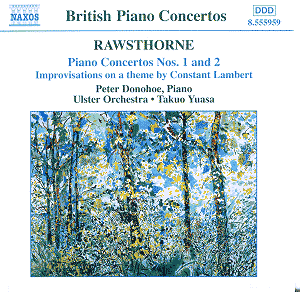Of all the excellent projects that Naxos has
on the go, this could prove one of the most valuable. Peter Donohoe
aims to resurrect neglected British piano concertos and make sure
they are given new digital recordings. Rawsthorne’s two piano
concerto are not particularly neglected in the record catalogue,
but it makes a good place to start and complements Naxos’s excellent
disc of the violin concertos.
In fact, there is pretty stiff competition for
this disc. There are a couple of historic performances from Moura
Lympany (No.1) and Denis Matthews (No.2) (on a disc recently deleted
by EMI and currently available from Berkshire Record Outlet. Ed.),
a good 1983 recording from John Ogdon (No.2 again), and an excellent
Chandos version from Geoffrey Tozer of both concertos. This last
disc has the original orchestration of No.1 and a different (possibly
more valuable) coupling in the Double Piano Concerto. In any case,
Naxos’s price means it’s not a problem to duplicate, and given
their massive market profile, this new disc is likely to win a
whole new set of friends for the pieces.
So it’s just as well the recording can be recommended.
The works themselves are readily accessible, with fairly short
movements that have plenty of life and colour. Rawsthorne favours
toccata-style writing for the piano in quite a few places, and
this, coupled with the soaring, angular lyricism, has led to comparisons
with Prokofiev. This is not inappropriate, and is possibly why
Donohoe revels in the textures, as he is a major Prokofiev exponent
(as well as another composer who occasionally came to mind, Bartók).
The youthful vigour and sheer brio of
the First Concerto should really make it a concert hall favourite.
The composer was himself an accomplished pianist and knew what
he was doing here, so it’s good to hear Donohoe on fine, sometimes
steely-fingered form. There are some very tricky passages to negotiate
in both works, but this sort of virtuosity is meat and drink to
this artist. Some of the more lyrical phrases could have breathed
a little more, and Tozer, sensitively accompanied by Mathias Bamert
and the LPO, is allowed to indulge himself in places. It also
must be said that the Naxos recording has nowhere near the transparency
and detail of the Chandos, and textures are occasionally muddied,
with some of the interesting wind lines blurred. The Ulster Orchestra
are on enthusiastic form however and, possibly inspired by their
soloist, really rise to the occasion.
The filler is most welcome, showing Rawsthorne’s
harmonic probing and adventurousness. Though the disc still comes
in at fairly short measure, no-one is likely to complain, given
the excellence of this music making and, of course, the famously
low price. Let’s hope, like the Bax symphony series, that it goes
from strength to strength. Heartily recommended.
Tony Haywood
see also review
by Colin Clarke
